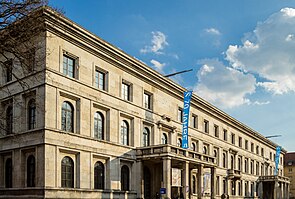Central Institute for Art History
Coordinates: 48 ° 8 ′ 40.2 ″ N , 11 ° 33 ′ 59.4 ″ E
| Central Institute for Art History - ZI - 
|
|
|---|---|
 Institute building on Katharina-von-Bora-Strasse (formerly Meiserstr.) 10 |
|
| Category: | Research facility, library |
| Carrier: | Free State of Bavaria |
| Facility location: | Munich |
| Subjects: | Art history |
| Management: | Ulrich Pfisterer |
| Homepage: | www.zikg.eu |
The Central Institute for Art History (ZI) in Munich is a central research institution for art history in Germany.
history
It was founded in November 1946 and started operating on March 1, 1947. From the beginning, the central institute has been based in the former NSDAP administration building, which is now the house of the cultural institutes in the Munich art area . In June 1945 the American military government set up a collection point in the building on Königsplatz for the repatriation of the works of art captured by the National Socialists , the “ Central Art Collecting Point ”, from which the “Central Art Institute” emerged. Its founding director was the art historian Ludwig Heinrich Heydenreich (1903–1978). He was followed from 1970 to 1989 by Willibald Sauerländer (1924–2018) in the management. From 1991 to 2017 Wolf Tegethoff (* 1953) was director of the central institute. From June 2015 to December 2017 he shared management with Ulrich Pfisterer , who has been the sole director of the Central Institute since January 2018.
The central institute
The institute sees itself as "a place of scientific exchange and international encounters" and as the only art historical research institute of supraregional importance in Germany and is also the only non-university art historical research institute in the Federal Republic of Germany. The central institute organizes lectures and conferences and shows exhibitions. The institute's various publications include the Reallexikon zur Deutschen Kunstgeschichte (since January 2015 rdklabor.de), the monthly Kunstchronik and the RIHA Journal .
The Central Institute in Germany offers unique opportunities for art historical research: The library of the Central Institute, a presence and open access library holds about 600 000 volumes, about 1,250 continuously subscribed journals and more than 60,000 auction catalogs, making it one of the world's largest art libraries. The library records its holdings via an OPAC composite catalog, the Kubikat, which it maintains together with three German art historical institutes abroad, the Art History Institute in Florence , the Bibliotheca Hertziana in Rome and the German Forum for Art History in Paris. The cubicate shows not only individual volumes but also essays.
The Central Institute's photo library is one of the largest study collections on European art history from the early Middle Ages to the 21st century. The holdings, which are freely accessible to all visitors, are divided into five sections: Topography (architecture and urban development, alphabetically according to countries and locations); Artists (visual arts, alphabetically by name); Museum topography (anonymous works in collections, alphabetically by location); Illumination (by place); Applied arts (according to material and storage locations). Some parts of the holdings are presented separately as closed special collections, such as Erich Meyer's estate or the “Schrey Collection”. The photo library has around 900,000 media units. It contains the "Image Archive of German Art" with 275,000 photographs, which was built between 1961 and 1975 with funding from the Fritz Thyssen Foundation. In addition to around 770,000 black and white prints, including many historically valuable photographs from the second half of the 19th century, the photo library has a large number of color slides and negatives, most of which are also available in digital form. This also includes the online color slide archive for wall and ceiling painting and microfiche collections. The color slide archive for wall and ceiling painting has also been integrated into the Prometheus picture archive since November 2005 . Numerous works of art that were shown at major exhibitions in National Socialist Germany were no longer shown after 1945 and were also not shown. The Zentralinstitut has been making them available online again since October 2011 in order to enable a social and art-historical debate.
See also
literature
- Iris Lauterbach (Red.): The Central Institute for Art History. Munich 1997, ISBN 3-00-001375-X .
- Iris Lauterbach: The founding of the Central Institute for Art History. In: Christian Drude, Hubertus Kohlen (Ed.): 200 years of art history in Munich. Munich 2003, pp. 168-181.
- Iris Lauterbach: The Central Collecting Point in Munich. Art protection, restitution, a new beginning. Munich, 2015
- Iris Lauterbach: Central Institute for Art History. In: Historical Lexicon of Bavaria
Web links
- Official website
- Kubikat , the catalog listing the holdings of the library of the Central Institute
- RDK laboratory
Individual evidence
- ↑ Central Institute for Art History. In: zikg.eu. Retrieved January 9, 2018 .
- ↑ Mission and History. In: zikg.eu. Retrieved January 9, 2018 .
- ↑ Prof. Dr. Ulrich Pfisterer. In: zikg.eu. Retrieved January 8, 2018 .
- ↑ a b Central Institute for Art History. Retrieved March 27, 2013 .
- ↑ Calendar overview . In: zikg.eu. Retrieved May 16, 2018 .
- ↑ exhibitions. In: zikg.eu. Retrieved May 16, 2018 .
- ↑ Kia Vahland : Raids are a science in themselves. The Central Institute for Art History turns seventy. In: Süddeutsche Zeitung of March 17, 2017, p. 12.
- ↑ kubikat union catalog. In: zikg.eu. Retrieved March 27, 2013 .
- ↑ Photo library. In: zikg.eu. Retrieved March 27, 2013 .
- ↑ color slide archive. In: Prometheus. Retrieved March 27, 2013 .
- ↑ Julia Voss: A taboo is broken. In: faz.net. October 17, 2011, accessed October 19, 2011 .
- ↑ GDK Research - Image-based research platform to the Great German Art Exhibitions 1937-1944 in Munich , Central Institute for Art History in cooperation with the German Historical Museum and the Haus der Kunst; 2011, accessed April 30, 2016